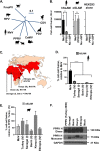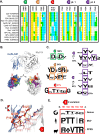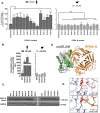Structure-Guided Identification of a Nonhuman Morbillivirus with Zoonotic Potential
- PMID: 30232185
- PMCID: PMC6232486
- DOI: 10.1128/JVI.01248-18
Structure-Guided Identification of a Nonhuman Morbillivirus with Zoonotic Potential
Abstract
Morbilliviruses infect a broad range of mammalian hosts, including ruminants, carnivores, and humans. The recent eradication of rinderpest virus (RPV) and the active campaigns for eradication of the human-specific measles virus (MeV) have raised significant concerns that the remaining morbilliviruses may emerge in so-called vacated ecological niches. Seeking to assess the zoonotic potential of nonhuman morbilliviruses within human populations, we found that peste des petits ruminants virus (PPRV)-the small-ruminant morbillivirus-is restricted at the point of entry into human cells due to deficient interactions with human SLAMF1-the immune cell receptor for morbilliviruses. Using a structure-guided approach, we characterized a single amino acid change, mapping to the receptor-binding domain in the PPRV hemagglutinin (H) protein, which overcomes this restriction. The same mutation allowed escape from some cross-protective, human patient, anti-MeV antibodies, raising concerns that PPRV is a pathogen with zoonotic potential. Analysis of natural variation within human and ovine SLAMF1 also identified polymorphisms that could correlate with disease resistance. Finally, the mechanistic nature of the PPRV restriction was also investigated, identifying charge incompatibility and steric hindrance between PPRV H and human SLAMF1 proteins. Importantly, this research was performed entirely using surrogate virus entry assays, negating the requirement for in situ derivation of a human-tropic PPRV and illustrating alternative strategies for identifying gain-of-function mutations in viral pathogens.IMPORTANCE A significant proportion of viral pandemics occur following zoonotic transmission events, where animal-associated viruses jump species into human populations. In order to provide forewarnings of the emergence of these viruses, it is necessary to develop a better understanding of what determines virus host range, often at the genetic and structural levels. In this study, we demonstrated that the small-ruminant morbillivirus, a close relative of measles, is unable to use human receptors to enter cells; however, a change of a single amino acid in the virus is sufficient to overcome this restriction. This information will be important for monitoring this virus's evolution in the field. Of note, this study was undertaken in vitro, without generation of a fully infectious virus with this phenotype.
Keywords: PPRV; host range; measles; morbillivirus; paramyxovirus; zoonoses.
Copyright © 2018 Abdullah et al.
Figures










Similar articles
-
Rinderpest and peste des petits ruminants viruses exhibit neurovirulence in mice.J Neurovirol. 2002 Feb;8(1):45-52. doi: 10.1080/135502802317247802. J Neurovirol. 2002. PMID: 11847591
-
Monoclonal antibody-based competitive ELISA for simultaneous detection of rinderpest virus and peste des petits ruminants virus antibodies.Vet Microbiol. 2003 Oct 8;96(1):1-16. doi: 10.1016/s0378-1135(03)00201-3. Vet Microbiol. 2003. PMID: 14516703
-
Immune responses in goats to recombinant hemagglutinin-neuraminidase glycoprotein of Peste des petits ruminants virus: identification of a T cell determinant.Vaccine. 2001 Sep 14;19(32):4816-23. doi: 10.1016/s0264-410x(01)00210-9. Vaccine. 2001. PMID: 11535334
-
Peste des Petits Ruminants Virus.Adv Virus Res. 2016;95:1-42. doi: 10.1016/bs.aivir.2016.02.001. Epub 2016 Mar 14. Adv Virus Res. 2016. PMID: 27112279 Review.
-
Peste des petits ruminants virus infection of small ruminants: a comprehensive review.Viruses. 2014 Jun 6;6(6):2287-327. doi: 10.3390/v6062287. Viruses. 2014. PMID: 24915458 Free PMC article. Review.
Cited by
-
Molecular epidemiology of peste des petits ruminants virus emergence in critically endangered Mongolian saiga antelope and other wild ungulates.Virus Evol. 2021 Jun 25;7(2):veab062. doi: 10.1093/ve/veab062. eCollection 2021. Virus Evol. 2021. PMID: 34754511 Free PMC article.
-
Human SLAM-adapted canine distemper virus can enter human peripheral blood mononuclear cells and replicate in mice expressing human SLAM and defective for STAT1 expression.Virulence. 2025 Dec;16(1):2457967. doi: 10.1080/21505594.2025.2457967. Epub 2025 Feb 21. Virulence. 2025. PMID: 39981650 Free PMC article.
-
Comparative evolutionary analyses of peste des petits ruminants virus genetic lineages.Virus Evol. 2024 Mar 6;10(1):veae012. doi: 10.1093/ve/veae012. eCollection 2024. Virus Evol. 2024. PMID: 38476867 Free PMC article.
-
Application of error-prone PCR to functionally probe the morbillivirus Haemagglutinin protein.J Gen Virol. 2021 Apr;102(4):001580. doi: 10.1099/jgv.0.001580. J Gen Virol. 2021. PMID: 33739251 Free PMC article.
-
Evolutionary and structural basis of SLAMF1 utilization in morbilliviruses-Implications for host range and cross-species transmission.PLoS Pathog. 2025 Jun 10;21(6):e1012990. doi: 10.1371/journal.ppat.1012990. eCollection 2025 Jun. PLoS Pathog. 2025. PMID: 40493685 Free PMC article.
References
-
- WHO. 2015. Measles fact sheet no. 286. WHO, Geneva, Switzerland.
-
- Ohishi K, Suzuki R, Maeda T, Tsuda M, Abe E, Yoshida T, Endo Y, Okamura M, Nagamine T, Yamamoto H, Ueda M, Maruyama T. 2014. Recent host range expansion of canine distemper virus and variation in its receptor, the signaling lymphocyte activation molecule, in carnivores. J Wildl Dis 50:596–606. doi:10.7589/2013-09-228. - DOI - PubMed
-
- OIE, FAO. 2015. Global control and eradication of peste des petits ruminants. Investing in veterinary systems, food security and poverty alleviation. PPRV summary document. World Organization for Animal Health (OIE); Food and Agriculture Organization of the United Nations (FAO), Washington, DC.
-
- Bodewes R, Morick D, van de Bildt MW, Osinga N, Rubio Garcia A, Sanchez Contreras GJ, Smits SL, Reperant LA, Kuiken T, Osterhaus AD. 2013. Prevalence of phocine distemper virus specific antibodies: bracing for the next seal epizootic in north-western Europe. Emerg Microbes Infect 2:e3. doi:10.1038/emi.2013.2. - DOI - PMC - PubMed
Publication types
MeSH terms
Substances
Grants and funding
- BBS/E/I/00007034/BB_/Biotechnology and Biological Sciences Research Council/United Kingdom
- BBS/E/I/00007037/BB_/Biotechnology and Biological Sciences Research Council/United Kingdom
- 098406/Z/12/B/WT_/Wellcome Trust/United Kingdom
- MR/P021735/1/MRC_/Medical Research Council/United Kingdom
- BB/R019843/1/BB_/Biotechnology and Biological Sciences Research Council/United Kingdom
LinkOut - more resources
Full Text Sources
Other Literature Sources

